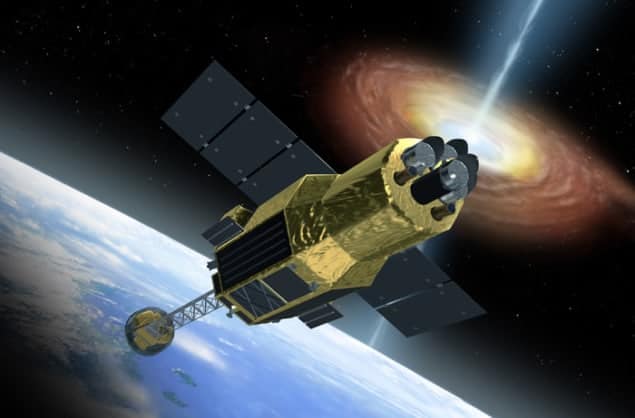
The Japanese Space Agency, JAXA, has launched its heaviest space mission to date – a huge X-ray probe that will study galaxy clusters, active galactic nuclei and supernova remnants. Launched from the Tanegashima Space Center by a H-IIA rocket today at 17:45 local time, ASTRO-H – weighing 2700 kg and measuring 14 m long – will now be placed in a low-Earth orbit at an altitude of 575 km, where it will operate for three years.
Many objects in deep space – including black holes, neutron stars, and galaxy clusters – emit X-rays as well as visible light. As the Earth’s atmosphere blocks X-rays from reaching land-based telescopes, the best way to study X-rays from deep space is to use an orbiting telescope.
ASTRO-H is a multipurpose X-ray observatory that will aim to explore the structure and evolution of the universe, including the distribution of dark matter in galaxy clusters. “ASTRO-H will extend the frontier of high-resolution X-ray spectroscopy,” ASTRO-H project manager Tadayuki Takahashi from the University of Tokyo told physicsworld.com. “ASTRO-H will determine the velocity field of the gas in clusters of galaxies and allow sensitive and precise measurements of how clusters grow and evolve, as well as measure the chemical composition of the gas in active galaxies that should allow measurements of the strength of the winds in these sources.”
Unique instrument
ASTRO-H contains four instruments including a gamma-ray detector, a soft X-ray spectrometer (SXS) and imager, as well as a hard X-ray imager. The craft will cover a wide energy range from 0.3 keV (soft X-rays) to 600 keV (gamma-rays), providing the highest energy resolution ever between 3–10 keV.
Indeed, the SXS will have an energy resolution of 7 eV – much better than previous missions such as NASA’s Chandra and Swift missions, as well as the European Space Agency’s XMM-Newton probe. “The SXS will be the first instrument capable of high spectral resolution for extended sources such as supernova remnants, normal galaxies and clusters of galaxies,” says Takahashi, “while the Hard X-ray Imager is only the second instrument that can provide very sensitive images and spectra in the 5–80 keV band.”
Astronomer David Burrows from Penn State University also thinks the SXS is a special instrument. “The most important capability is the extremely high energy resolution of the SXS,” he adds. “This will allow much better characterization of hot gas in clusters and supernova remnants – including measurements of both temperature and abundance – than has been possible until now.”
The ASTRO-H launch comes shortly after India sent its own X-ray mission into space in September. Dubbed Astrosat, it surveys the skies in the hard X-ray and ultraviolet bands, as well as monitoring the sky for new transients and studying X-ray binaries, active galactic nuclei and clusters of galaxies. “ASTRO-H is a very exciting X-ray astronomy mission that the community of X-ray astronomers had been looking forward to for quite some time,” says K P Singh from the Tata Institute of Fundamental Research, who was a lead scientist for one of Astrosat’s instruments.
“ASTRO-H is a very exciting project for high-energy astrophysics and in some ways it will start a new era in X-ray astronomy,” says Kirpal Nandra, a director at the Max Planck Institute for Extraterrestrial Physics in Garching, Germany, who is also lead scientist on the European Space Agency’s planned Athena X-ray observatory. “ASTRO-H is an extremely ambitious and complex mission. It continues a great tradition in Japanese X-ray astronomy.”
ASTRO-H has been built by an international collaboration of more than 70 contributing institutions in Canada, Europe, Japan and the US. Takahashi told physicsworld.com that he is “very proud” that such a large international team has come together to build the craft. “The power of ASTRO-H will certainly discover unexpected phenomena,” he adds.



